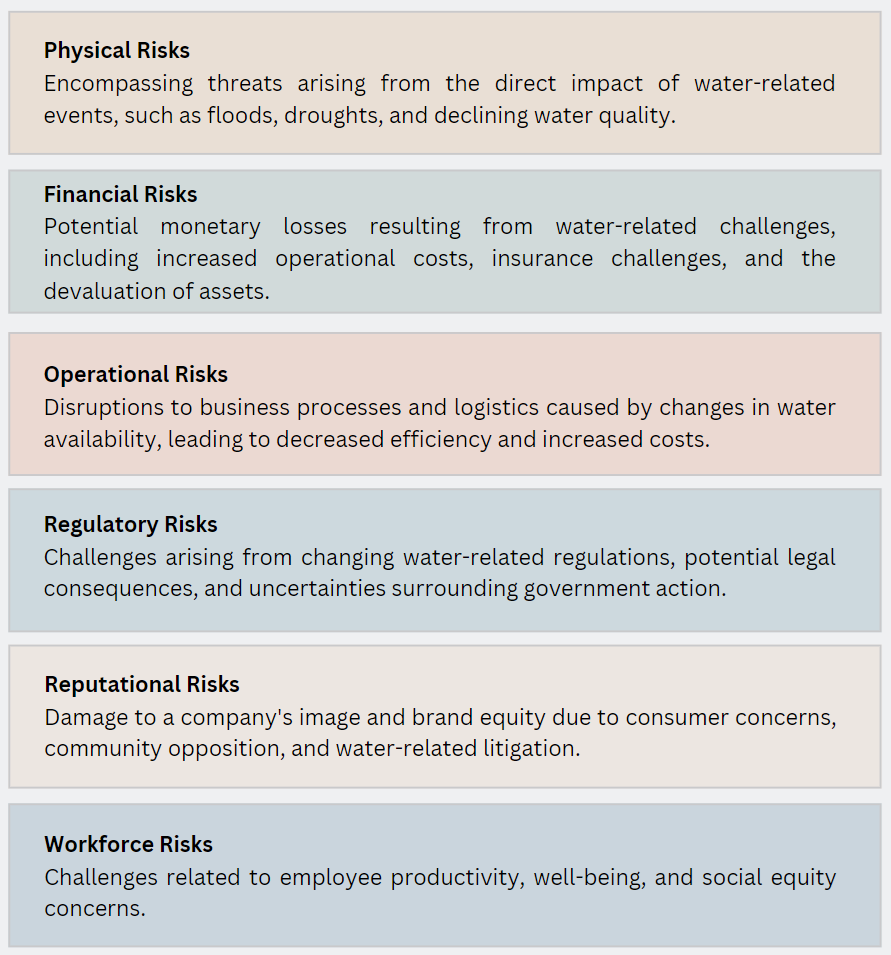In a time marked by an unprecedented surge in global water demand, coupled with expanding urban populations and the overexploitation of freshwater resources, the threat of water risk looms as a critical challenge with far-reaching consequences. Here, we outline some of the potential threats and highlight the urgent need for sustainable water management practices.
Clean, high-quality water is on track to become an increasingly scarce commodity. At the current pace of industrial activity, we can expect a 53% shortfall in global water supply by 2050. Simultaneously, many cities are dealing with the effects of climate change, including increasingly frequent and intense weather events. These problems are not only a concern for individuals and communities but pose a profound threat to business operations worldwide.
Water risk is not confined to arid regions or distant future scenarios; it is a pressing issue that has the potential to disrupt businesses across industries here and now. From manufacturing and agriculture to technology and hospitality, enterprises face multifaceted risks stemming from inadequate access to a steady supply of clean water and the effects of unpredictable weather. The business impact will manifest in various ways, ranging from operational disruptions and increased production costs to reputational damage and regulatory challenges.
Here, we outline the key risk categories with the goal of highlighting the urgent need for sustainable water management practices and the pivotal role businesses must play in securing a resilient future.
For businesses, water risk manifests in a variety of ways across several key categories:

Physical Risks
- Drought and Water Quality Concerns: Water scarcity due to prolonged droughts can lead to reduced water availability for operations – affecting agricultural processes and energy generation. Declining water quality poses health risks to employees and communities, potentially leading to increased healthcare costs and reputational damage.
- Flooding & Severe Weather Impacts: Beyond the immediate damage to your infrastructure and operational equipment, flooding can also disrupt supply chains; leading to production delays and increased recovery costs. It may also necessitate investments in resilient infrastructure and flood defenses to mitigate future risks.
Financial Risks
- Price Volatility: Fluctuations in water availability can lead to price volatility for goods and services. Companies relying heavily on water-intensive processes may experience increased production costs – affecting profit margins and competitiveness.
- Insurance Challenges: Water-related damage may pose challenges for businesses in obtaining insurance coverage, especially in regions prone to floods or other future water-related disasters.
- Investor Relations Risk: Investors are increasingly considering water-related risks and sustainability in their investment decisions. Poor water management practices can negatively impact a business’ standing in Environmental, Social, Governance (ESG) evaluations and hinder efforts to raise capital or finance new opportunities.
Operational Risks
- Supply Chain Vulnerability: Dependency on suppliers in water-stressed regions increases the vulnerability of the supply chain. Inconsistencies or reductions in the availability of raw materials or ingredients due to water scarcity can result in increased costs and cause production or shipping delays.
- Production Zone Changes: Shifting weather patterns or water availability may necessitate changes in production zones. This could result in increased transportation costs, the need for new infrastructure investment, and potential disruptions to established production processes; affecting overall operational efficiency.
- Stranded Assets: Investments in water-intensive assets may become stranded due to changing environmental conditions or regulatory requirements. This poses financial risks as companies may need to write down the value of stranded assets or invest in costly retrofits.
- Business Continuity Risk: Inadequate contingency planning for water-related disruptions may result in extended downtime and exacerbate near-term financial losses.
- Innovation Risk: Failure to adapt and invest in innovative, water-efficient technologies or infrastructure may lead to increased operational costs and resource inefficiency and can hinder future growth.
Regulatory Risks
- Government Action: Failure to anticipate and adapt to changing regulations related to water use, allocation, or quality standards may result in legal and financial repercussions, including potentially losing the license to operate.
- Legal Consequences: Non-compliance with water-related regulations can lead to legal action, fines, and sanctions.
Reputational Risks
- Consumer Perception: As corporate sustainability commitments become increasingly important, consumer concerns about a company’s water management practices can negatively impact brand image and loyalty.
- Community Opposition: Resistance from local communities to projects perceived as water-intensive or environmentally harmful can lead to broader reputational damage.
Workforce Risks
- Employee Productivity: Water scarcity can affect employee well-being and productivity, especially in regions facing water stress. Implementing water conservation measures and ensuring access to clean water for employees can contribute to a healthier and more engaged workforce.
